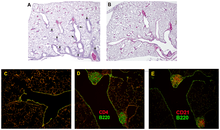Bronchus-associated lymphoid tissue

Bronchus-associated lymphoid tissue (BALT) is a tertiary lymphoid structure and it is a part of mucosa-associated lymphoid tissue (MALT) and it consist of lymphoid follicles in lungs and bronchus. BALT is effective priming site of mucosal and systemic immune response.[1]
Structure
BALT is similar in most mammal species, but it differs in its maintenance and inducibility. While it is normal component of lungs and bronchus in rabbits or pigs, in mice or humans it appears only after infection or inflammation.[2] In mice and humans it is thus called inducible BALT (iBALT). BALT and iBALT are structurally and functionally very similar, so in this article is used only BALT for both structures.
BALT is found along the bifurcations of the upper bronchi directly beneath the epithelium and generally lying between an artery and a bronchus. It is also in perivascular, peribronchial and even interstitial areas in the lower airways of the lung.[3] To call it BALT it has to be structured accumulation of lymphocytes and other immune cells. There are lymphoid follicles with apparent germinal centres with most B-cells surrounded by T-cell area. In interfollicular T-cell area, there are many dendritic cells presenting antigen to T-cells and in germinal centres, there are follicular dendritic cells. There are CD4+ Th lymphocytes in germinal centres and interfollicular area and CD8+ T cells mainly in interfollicular area. High endothelial venules (HEVs) are also present in BALT in T/B-cell interface, allowing for the recruitment of naive T cells.[4] These HEV are the only entry site for lymphocytes to migrate into the BALT and leave by efferent lymphatic vessels. In some species, M cells have been described in epithelium above BALT similar to M cells in the dome epithelium of Peyer’s patches, although the dome epithelium is not typical for BALT.[2]
For formation of BALT in mice is necessary inteleukin-17 and VCAM-1, PNAd and LFA-1 and it is lymphotoxin-α independent whereas the development of secondary lymphoid organs (such as lymph nodes and Peyer’s patches) is typically dependent on LTα.[4][5][6] Formation of BALT may be caused by disabled in situ function of Treg cells.[7]
Function
Function and purpose of BALT is not completely known yet. It is also unclear if its formation is part of normal immune response or if it is pathologic and should be suppressed.
BALT is included in the efficient priming of adaptive B-cell and T-cell responses directed against airborne antigens. It needs dendritic cells to its maintenance and function.[8] Inducible BALT is formed after infection, e.g. influenza, and peak in size between 1 and 2 weeks after infection and diminish thereafter. Immune responses initiated in iBALT are delayed relative to the immune response in the draining lymph nodes, owing to the time it takes to form iBALT. But in chronic disease iBALT may be a component of the pathology.[4] BALT can be induced even in fetal lungs after chorioamnionitis or intrauterine pneumonia.[2] Also there is an evidence that cigarette smoke can induce formation of BALT in humans and rats.[9] BALT can also occur after other stimuli, e.g. inflammation caused by rheumatoid arthritis or other autoimmune lung disease or mechanic damage by dust particles.[3]
References
- ↑ Advances in Immunology. Academic Press. 2010-11-26. ISBN 9780123813015.
- 1 2 3 Tschernig, Thomas, and Reinhard Pabst. "Bronchus-associated lymphoid tissue (BALT) is not present in the normal adult lung but in different diseases." Pathobiology 68.1 (2000): 1-8.
- 1 2 Rangel-Moreno, Javier; Hartson, Louise; Navarro, Carmen; Gaxiola, Miguel; Selman, Moises; Randall, Troy D. (2006-12-01). "Inducible bronchus-associated lymphoid tissue (iBALT) in patients with pulmonary complications of rheumatoid arthritis". The Journal of Clinical Investigation. 116 (12): 3183–3194. ISSN 0021-9738. PMID 17143328. doi:10.1172/jci28756.
- 1 2 3 Moyron-Quiroz, Juan E.; Rangel-Moreno, Javier; Kusser, Kim; Hartson, Louise; Sprague, Frank; Goodrich, Stephen; Woodland, David L.; Lund, Frances E.; Randall, Troy D. (September 2004). "Role of inducible bronchus associated lymphoid tissue (iBALT) in respiratory immunity". Nature Medicine. 10 (9): 927–934. ISSN 1078-8956. doi:10.1038/nm1091.
- ↑ Rangel-Moreno, Javier; Carragher, Damian M; Garcia-Hernandez, Maria de la Luz; Hwang, Ji Young; Kusser, Kim; Hartson, Louise; Kolls, Jay K; Khader, Shabaana A; Randall, Troy D. "The development of inducible bronchus-associated lymphoid tissue depends on IL-17". Nature Immunology. 12 (7): 639–646. PMC 3520063
 . PMID 21666689. doi:10.1038/ni.2053.
. PMID 21666689. doi:10.1038/ni.2053. - ↑ Xu, Baohui; Wagner, Norbert; Pham, Linh Nguyen; Magno, Vincent; Shan, Zhongyan; Butcher, Eugene C.; Michie, Sara A. (2003-05-19). "Lymphocyte Homing to Bronchus-associated Lymphoid Tissue (BALT) Is Mediated by L-selectin/PNAd, α4β1 Integrin/VCAM-1, and LFA-1 Adhesion Pathways". Journal of Experimental Medicine. 197 (10): 1255–1267. ISSN 0022-1007. PMC 2193791
 . PMID 12756264. doi:10.1084/jem.20010685.
. PMID 12756264. doi:10.1084/jem.20010685. - ↑ Kocks, Jessica R.; Davalos-Misslitz, Ana Clara Marques; Hintzen, Gabriele; Ohl, Lars; Förster, Reinhold (2007-04-16). "Regulatory T cells interfere with the development of bronchus-associated lymphoid tissue". Journal of Experimental Medicine. 204 (4): 723–734. ISSN 0022-1007. PMC 2118537
 . PMID 17371929. doi:10.1084/jem.20061424.
. PMID 17371929. doi:10.1084/jem.20061424. - ↑ Halle, Stephan; Dujardin, Hélène C.; Bakocevic, Nadja; Fleige, Henrike; Danzer, Heike; Willenzon, Stefanie; Suezer, Yasemin; Hämmerling, Günter; Garbi, Natalio (2009-11-23). "Induced bronchus-associated lymphoid tissue serves as a general priming site for T cells and is maintained by dendritic cells". Journal of Experimental Medicine. 206 (12): 2593–2601. ISSN 0022-1007. PMC 2806625
 . PMID 19917776. doi:10.1084/jem.20091472.
. PMID 19917776. doi:10.1084/jem.20091472. - ↑ Richmond, I.; Pritchard, G. E.; Ashcroft, T.; Avery, A.; Corris, P. A.; Walters, E. H. (1993-11-01). "Bronchus associated lymphoid tissue (BALT) in human lung: its distribution in smokers and non-smokers.". Thorax. 48 (11): 1130–1134. ISSN 0040-6376. PMID 8296257. doi:10.1136/thx.48.11.1130.